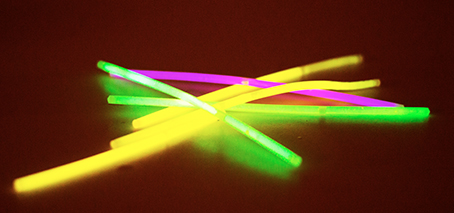Something fun and simple – playing with glow sticks. Fascinate kids by looking into some science behind glow sticks and chemical reactions.
What you need:
- glow sticks
- very hot water
- ice cold water
What to do:
- Crack a glow stick so it starts to glow. It works best if you get the room dark.
- Put the glow stick in a cup of ice cold water. It should become dull, you might not even be able to tell that it’s glowing.
- Put the glow stick in hot water. You can get your water hot by boiling it and then letting it sit for about 5 minutes so it is not still boiling. The glow stick should start to glow very brightly.
- Try moving the glow stick between the hot and cold water. It will go dull every time it is in the cold water, and bright every time it is in the hot water.
- Try holding the glow stick tightly in your hand to warm it up. What happens to the section you were holding?
What happens:
Glow sticks light up because of chemiluminescence. This happens because when you crack the glow stick, you break a glass tube inside with one chemical in it, which then mixes with another chemical in the plastic part. The reaction between the two chemicals causes chemiluminescence. If you want to, being very careful, you can cut the tip off a glow stick (one that is not cracked) so you can remove the glass tube inside to see what it actually looks like. The box usually warns against this, as you are dealing with chemicals. Be careful not to swallow it, clean up any spills and wash your hands after you are done.
The glowing practically stops in the ice cold water because chemical reactions happen faster at high temperatures. When the glow stick cools down, the chemical reaction is happening slower, so slow you can barely see it. The opposite happens when it is in the hot water, with the reaction speeding up.

